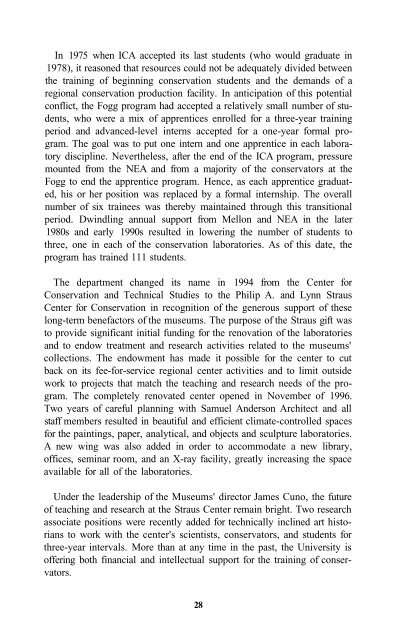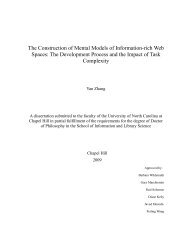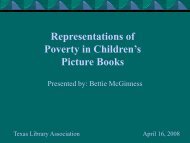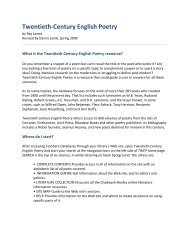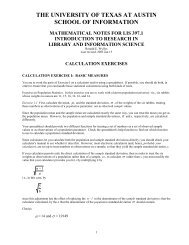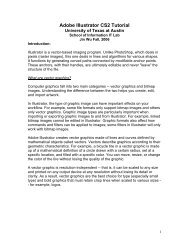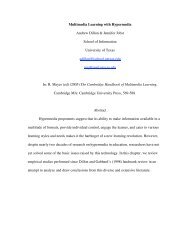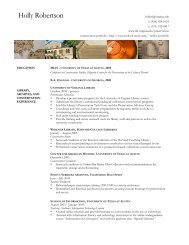North American Graduate Programs in the Conservation of
North American Graduate Programs in the Conservation of
North American Graduate Programs in the Conservation of
Create successful ePaper yourself
Turn your PDF publications into a flip-book with our unique Google optimized e-Paper software.
In 1975 when ICA accepted its last students (who would graduate <strong>in</strong><br />
1978), it reasoned that resources could not be adequately divided between<br />
<strong>the</strong> tra<strong>in</strong><strong>in</strong>g <strong>of</strong> beg<strong>in</strong>n<strong>in</strong>g conservation students and <strong>the</strong> demands <strong>of</strong> a<br />
regional conservation production facility. In anticipation <strong>of</strong> this potential<br />
conflict, <strong>the</strong> Fogg program had accepted a relatively small number <strong>of</strong> students,<br />
who were a mix <strong>of</strong> apprentices enrolled for a three-year tra<strong>in</strong><strong>in</strong>g<br />
period and advanced-level <strong>in</strong>terns accepted for a one-year formal program.<br />
The goal was to put one <strong>in</strong>tern and one apprentice <strong>in</strong> each laboratory<br />
discipl<strong>in</strong>e. Never<strong>the</strong>less, after <strong>the</strong> end <strong>of</strong> <strong>the</strong> ICA program, pressure<br />
mounted from <strong>the</strong> NEA and from a majority <strong>of</strong> <strong>the</strong> conservators at <strong>the</strong><br />
Fogg to end <strong>the</strong> apprentice program. Hence, as each apprentice graduated,<br />
his or her position was replaced by a formal <strong>in</strong>ternship. The overall<br />
number <strong>of</strong> six tra<strong>in</strong>ees was <strong>the</strong>reby ma<strong>in</strong>ta<strong>in</strong>ed through this transitional<br />
period. Dw<strong>in</strong>dl<strong>in</strong>g annual support from Mellon and NEA <strong>in</strong> <strong>the</strong> later<br />
1980s and early 1990s resulted <strong>in</strong> lower<strong>in</strong>g <strong>the</strong> number <strong>of</strong> students to<br />
three, one <strong>in</strong> each <strong>of</strong> <strong>the</strong> conservation laboratories. As <strong>of</strong> this date, <strong>the</strong><br />
program has tra<strong>in</strong>ed 111 students.<br />
The department changed its name <strong>in</strong> 1994 from <strong>the</strong> Center for<br />
<strong>Conservation</strong> and Technical Studies to <strong>the</strong> Philip A. and Lynn Straus<br />
Center for <strong>Conservation</strong> <strong>in</strong> recognition <strong>of</strong> <strong>the</strong> generous support <strong>of</strong> <strong>the</strong>se<br />
long-term benefactors <strong>of</strong> <strong>the</strong> museums. The purpose <strong>of</strong> <strong>the</strong> Straus gift was<br />
to provide significant <strong>in</strong>itial fund<strong>in</strong>g for <strong>the</strong> renovation <strong>of</strong> <strong>the</strong> laboratories<br />
and to endow treatment and research activities related to <strong>the</strong> museums'<br />
collections. The endowment has made it possible for <strong>the</strong> center to cut<br />
back on its fee-for-service regional center activities and to limit outside<br />
work to projects that match <strong>the</strong> teach<strong>in</strong>g and research needs <strong>of</strong> <strong>the</strong> program.<br />
The completely renovated center opened <strong>in</strong> November <strong>of</strong> 1996.<br />
Two years <strong>of</strong> careful plann<strong>in</strong>g with Samuel Anderson Architect and all<br />
staff members resulted <strong>in</strong> beautiful and efficient climate-controlled spaces<br />
for <strong>the</strong> pa<strong>in</strong>t<strong>in</strong>gs, paper, analytical, and objects and sculpture laboratories.<br />
A new w<strong>in</strong>g was also added <strong>in</strong> order to accommodate a new library,<br />
<strong>of</strong>fices, sem<strong>in</strong>ar room, and an X-ray facility, greatly <strong>in</strong>creas<strong>in</strong>g <strong>the</strong> space<br />
available for all <strong>of</strong> <strong>the</strong> laboratories.<br />
Under <strong>the</strong> leadership <strong>of</strong> <strong>the</strong> Museums' director James Cuno, <strong>the</strong> future<br />
<strong>of</strong> teach<strong>in</strong>g and research at <strong>the</strong> Straus Center rema<strong>in</strong> bright. Two research<br />
associate positions were recently added for technically <strong>in</strong>cl<strong>in</strong>ed art historians<br />
to work with <strong>the</strong> center's scientists, conservators, and students for<br />
three-year <strong>in</strong>tervals. More than at any time <strong>in</strong> <strong>the</strong> past, <strong>the</strong> University is<br />
<strong>of</strong>fer<strong>in</strong>g both f<strong>in</strong>ancial and <strong>in</strong>tellectual support for <strong>the</strong> tra<strong>in</strong><strong>in</strong>g <strong>of</strong> conservators.<br />
28


